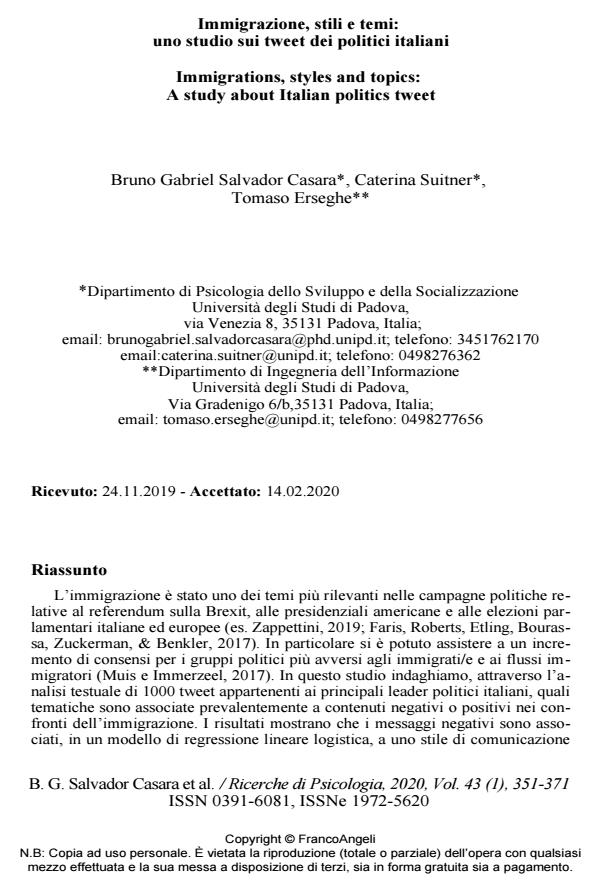Immigrations, styles and topics: A study about Italian politics tweet
Journal title RICERCHE DI PSICOLOGIA
Author/s Bruno Gabriel Salvador Casara, Caterina Suitner, Tomaso Erseghe
Publishing Year 2020 Issue 2020/1
Language Italian Pages 21 P. 351-371 File size 307 KB
DOI 10.3280/RIP2020-001016
DOI is like a bar code for intellectual property: to have more infomation
click here
Below, you can see the article first page
If you want to buy this article in PDF format, you can do it, following the instructions to buy download credits

FrancoAngeli is member of Publishers International Linking Association, Inc (PILA), a not-for-profit association which run the CrossRef service enabling links to and from online scholarly content.
Immigration has been one of the most relevant topics during the Brexit Referendum, United States presidential election, and Italian and European Parliament elections (e.g., Zappettini, 2019; Faris, Roberts, Etling, Bourassa, Zuckerman, & Benkler, 2017). In particular, during these events, the anti-immigration-politicalgroups gain consensus (Muis and Immerzeel, 2017). In this study, we investigate, with a text-analysis of 1000 Italian political leaders’ tweets, which topics are associated with negative or positive sentiment toward immigrants. The results show that negative messages are associated, in a logistic regression model, with a populistic communication style, and with conspiracy suspicions. Moreover, a network analysis reveals that anti-immigration messages are associated with security and justice topics, whereas pro-immigration messages are associated with the topics of civil rights, culture, and Europe. Stylistics elements of populist and conspiratorial communication and their relation with the diffusion of anti-immigration contents and related consequences on composition and transmission of values, in social media context, are discussed.
Keywords: Immigration, populism, conspiratorial communication, social media, politics communication
- Migrazioni e psicologie. Introduzione al Forum Alessandro Antonietti, Antonella Marchetti, in RICERCHE DI PSICOLOGIA 1/2020 pp.13
DOI: 10.3280/RIP2020-001002
Bruno Gabriel Salvador Casara, Caterina Suitner, Tomaso Erseghe, Immigrazione, stili e temi: uno studio sui tweet dei politici italiani in "RICERCHE DI PSICOLOGIA " 1/2020, pp 351-371, DOI: 10.3280/RIP2020-001016